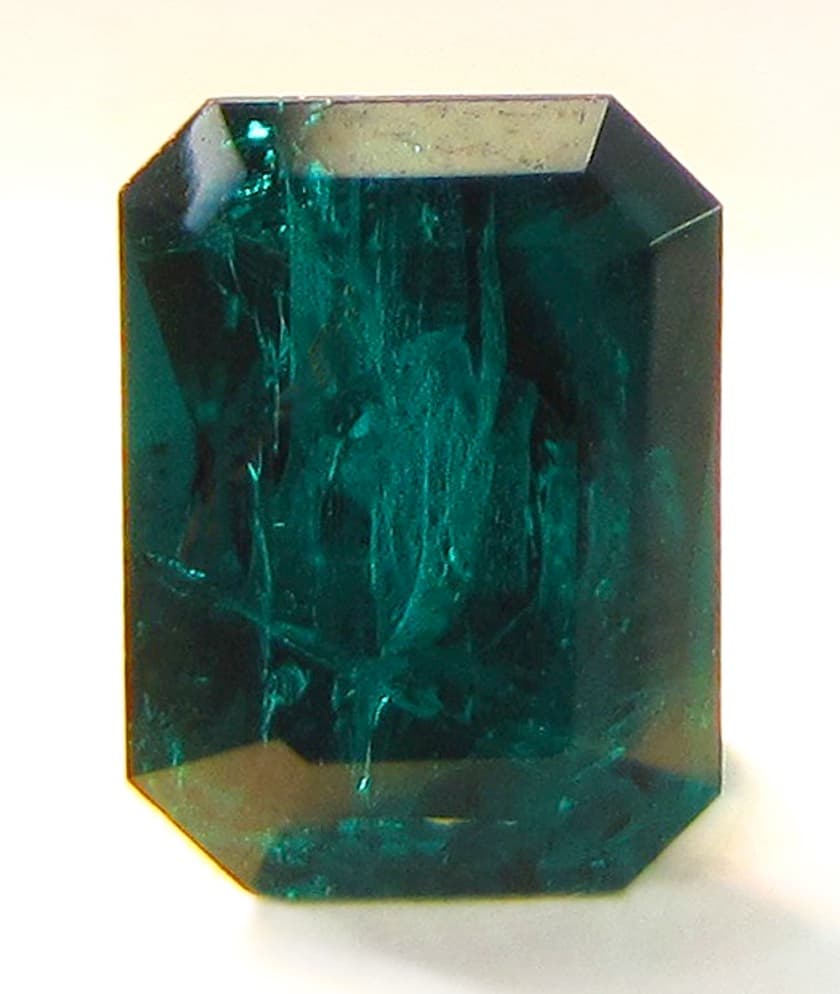Dioptase Value, Price, and Jewelry Information
Dioptase has a beautiful, emerald-like green color. Although this mineral isn’t rare, gems are seldom faceted because of a paucity of clean material over 1 carat.
3 Minute Read
Dioptase has a beautiful, emerald-like green color. Although this mineral isn’t rare, gems are seldom faceted because of a paucity of clean material over 1 carat.
Start an IGS Membership today
for full access to our price guide (updated monthly).Dioptase Value
Comments
Dioptases usually occur as micro-crystals. Although larger crystals can be found, they rarely have large clean areas, so any faceted gems rarely weigh more than 1 or 2 carats. Perfect cleavage can also make these gems difficult to facet. However, lapidaries can cut sizable cabochons from translucent dioptase masses.
Dioptase rough and cut set. Rough specimen: 4.5 x 4.2 x 4.0 cm (largest crystal: 1.2 cm); emerald-cut gem: 0.65 cts. Tsumeb Mine, Otjikoto, Namibia. © Rob Lavinsky, www.iRocks.com. Used with permission.
With their beautiful green colors and doubly terminated and often prismatic crystal shapes, dioptases are frequently found in mineral collections. They also make popular freeform and raw jewelry stones.
Identifying Characteristics
Dioptases have a pale blue-green streak. Keep in mind that streak testing is a destructive test. Conduct it only as a last resort for identification and never on a finished gem.
When heated, dioptase generates an electric charge. This property is known as pyroelectricity.
Faceted dioptases may show a birefringent doubling effect.
Distinguishing Dioptases from Popular Green Gems
Dioptases may resemble more well-known gemstones such as emeralds and peridots. Despite their similar colors, the optical and physical properties of dioptases and emeralds differ enough that gemologists can readily distinguish them. On the other hand, dioptases and peridots can have similar refractive indices (RI), pleochroic colors, and specific gravity (SG) values. However, they have distinct absorption spectra and different optic characters. (Dioptases also typically show darker green colors than peridots).
Green tourmalines may share many properties with dioptases. However, dioptase has a distinctive absorption spectrum.
"Emerald Copper" and "Emerald Malachite"
A hydrous copper silicate, dioptase has been called "emerald copper" because of its color. Dioptase can form in close association with malachite, another copper-bearing mineral. You may find dioptase specimens sometimes described as "emerald malachite," perhaps because their crystalline formations appear "gemmy," like emeralds, and their color is similar to that of more well-known malachites. Of course, dioptase, malachite, and emerald constitute three distinct gem species. This is likely another example of vendors falsely connecting a gemstone — in this case — with not one but two more well-known gemstones in an effort to increase consumer interest (and prices). See our list of false or misleading gemstone names for more examples.
Synthetics
Scientists have synthesized dioptases. However, there is no known jewelry use for this lab-created material.
Enhancements
No known gemstone treatments or enhancements.
Sources
Tsumeb, Guchab, and Kaokoveld, Namibia produce the world's finest crystals, with superb color, on matrix, and up to 2 inches long. Some are transparent but also filled with cleavage planes and fractures.
The dioptase type locality, Altyn-Tyube, Kazakhstan, also produces fine crystals.
In the United States, Arizona yields microscopic crystals.
Other notable sources include the following localities:
- Argentina; Chile; Democratic Republic of the Congo; Peru; Republic of the Congo.
Stone Sizes
Large crystals seldom produce gems larger than 2 carats. Masses may yield cabochons up to 15 carats.
Care
With perfect cleavage and a hardness of 5, dioptases need protective settings whether faceted, cabbed, or raw. These gems have greater susceptibility to scratches than other, more popular jewelry stones like tourmalines, peridots, and even emeralds. However, dioptases make excellent choices for earrings or brooches.
Due to its copper content, dioptase dust is toxic. Accidental ingestion could lead to acute distress, like vomiting, and chronic exposure could lead to liver and kidney damage. Faceters should wear protective masks and, ideally, use a glovebox to prevent inhaling or ingesting dioptase particles during cutting, polishing, and cleaning. However, wearing or handling finished pieces should pose no hazards.
Due to cleavage and possible fractures, dioptases should only be cleaned with a soft brush, mild detergent, and warm water. Consult our gemstone jewelry cleaning guide for more care recommendations.
Joel E. Arem, Ph.D., FGA
Dr. Joel E. Arem has more than 60 years of experience in the world of gems and minerals. After obtaining his Ph.D. in Mineralogy from Harvard University, he has published numerous books that are still among the most widely used references and guidebooks on crystals, gems and minerals in the world.
Co-founder and President of numerous organizations, Dr. Arem has enjoyed a lifelong career in mineralogy and gemology. He has been a Smithsonian scientist and Curator, a consultant to many well-known companies and institutions, and a prolific author and speaker. Although his main activities have been as a gem cutter and dealer, his focus has always been education.
International Gem Society
Related Articles
Faceting Tips for Exotic Gemstones
What is Moonstone Gemstone? Value, Price, and Color
Carnelian Value, Price, and Jewelry Information
Nambulite Value, Price, and Jewelry Information
Never Stop Learning
When you join the IGS community, you get trusted diamond & gemstone information when you need it.
Get Gemology Insights
Get started with the International Gem Society’s free guide to gemstone identification. Join our weekly newsletter & get a free copy of the Gem ID Checklist!




